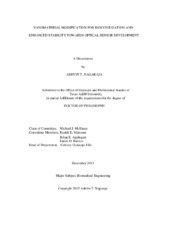| dc.description.abstract | The evolving field of nanomaterial synthesis needs adaptable techniques for the modification and construction of multifunctional components. In this work, a unique layer-by-layer (LbL) method is demonstrated as a generic pathway for nanomaterial stabilization and bioconjugation, facilitating manipulation and handling for new applications. In particular, nanomaterials have unique optical properties that can potentially improve the sensitivity and long-term performance in applications such as optical biosensors, particularly those based on energy transfer. However, the reproducible integration of nanomaterials into stable assays remains a significant challenge. Therefore, the generalized LbL technique was specifically applied towards the fabrication of a novel nanomaterial-enabled optical sensor.
The broader implications of this LbL technique on nanoparticles were explored by characterizing the capabilities and performance of multiple nanoscale core materials and prospective polymer coatings. The modified nanomaterials were characterized for their colloidal and optical stability under varying pH, buffer, and ionic strength conditions. A single bilayer coating of weak and weak-strong polymers using the developed procedure was capable of imparting colloidal stability with a minimal hydrodynamic size increase; an essential feature for energy transfer sensors.
The application of this LbL coating was demonstrated for the construction of a nanomaterial-enabled energy transfer sensor utilizing concanavalin A (ConA)-coated gold nanorods (energy acceptors) combined with fluorescent gold nanoclusters (NCs) grown within ovalbumin (OVA) (energy donors). The successful construction of the sensor components was verified and the concept demonstrated via reversible quenching in the presence of increasing glucose concentrations.
Calcium carbonate was explored as a porous template for the encapsulation of affinity sensing chemistry. The entire process was studied; synthesis of the carbonate template, capsule formation via LbL, and dissolution of carbonate to form a hollow capsule, along with the incorporation of assay components using co-precipitation. The knowledge gained provides fundamental insight for improving the function of sensor schemes utilizing carbonate and to guide future considerations for encapsulation.
These results demonstrate significant advances for the reliable fabrication of nanomaterial-enabled optical sensors. The fundamental knowledge and experimental expertise developed shall guide the rational design of future sensor iterations for improved performance. | en |


